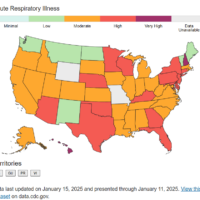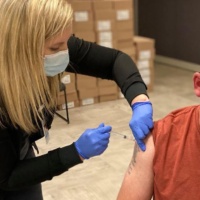In March 2020, my parents returned home from a trip to New Zealand (my dad’s home country) to what seemed like a completely different world.
The World Health Organization had declared a global pandemic. President Donald Trump had told Americans to avoid gathering in groups of more than 10. Several states had ordered bars and restaurants closed. The NBA had halted its season and Tom Hanks was in isolation. More than 4,000 COVID-19 cases and nearly 100 deaths had been confirmed in the United States.
At that point, there had only been eight cases confirmed in New Zealand. On the day of their departure, one of those individuals traveled through the same airport as my parents.
Then, about a week and a half after getting back to their home in Indiana, my dad got sick.
At the time, it was nearly impossible to get tested for COVID-19. Despite his symptoms and recent international travel, he was turned away twice from the local hospital testing clinic. Finally, after much assistance from his family physician, he was able to acquire an appointment.
Thankfully, he tested negative and he recovered shortly thereafter. But he was one of many who, during the early months of the pandemic, struggled to get tested. Tests were so limited that some were never tested, despite being diagnosed with the virus.
COVID-19 testing has come a long way since then, but there’s still progress to make.
Earlier this month, President Joe Biden announced plans to expand testing nationwide, including a forthcoming federal rule that all businesses with 100 or more employees have to ensure their workers are vaccinated or submitting to weekly COVID-19 testing.
“From the start, America has failed to do enough COVID-19 testing,” he said during a speech on Sept. 9 outlining his COVID-19 plan, which also includes boosting access to at-home tests, expanding free testing around the country, and spending $2 billion to purchase nearly 300 million rapid tests for distribution to community health centers, food banks and schools.
This week, Christian County’s school district marked a shift toward increased testing, announcing that effective Monday it would begin offering a “Test to Stay” option for students and teachers exposed to the virus in a school setting. The optional alternative to the district’s previous 10-day quarantine policy allows close contacts to take a series of five COVID-19 tests — and continue attending school in person as long as they test negative.
As COVID-19 testing ramps up locally and nationwide, it’s important to understand what tests can — and can’t — tell you.
First, let’s review the two main types of tests used to diagnose infection with COVID-19:
Nucleic acid amplification tests (NAAT): These type of tests, which looks for the virus’s genetic material, have been considered the “gold standard.” They are highly sensitive and detect a current or recent infection. The most common and widely available test, the PCR, is a type of NAAT test. They have to be sent to a lab for processing, which typically takes one to three days. A positive result almost certainly means you’re infected with the virus.
Antigen tests: which are often referred to as rapid tests, detect specific proteins on the surface of the virus and can identify people who are at the peak of infection — when individuals are presumed to be infectious. They are less sensitive than NAAT tests and are more likely to produce false-negative results. Because they are cheaper and can be processed in 15 to 30 minutes, they’re often used for large-scale screening purposes, like the school district’s “Test to Stay” program.
Not all negative results are created equal
I recently traveled for the first time since the pandemic began. Because of travel regulations, I was required to take three COVID-19 tests over the course of my trip. I also coordinated testing for my four travel companions. Two of the three times we tested were with rapid antigen tests.
During the trip, I realized a couple of my travel companions shared a common misconception: That a negative result means you don’t have COVID-19.
Not so, at least with antigen tests.
It does mean that the test didn’t detect any antigens, so you’re probably not highly infectious on the day you took it.
Dr. Michael Mina, an epidemiologist at Harvard University and advocate of widespread rapid testing, has coined a phrase that captures the concept well. He suggests thinking of antigen tests as “contagiousness tests” — specifically, for the day you took the test. They won’t tell you if you were contagious last week or will become contagious tomorrow.
Antigen tests work best when taken a few times over the course of a week rather than just once (which is why they are often sold in packages of two or more). The idea is, if you take the first test within a few days of contracting the virus and it’s negative, it’s likely that by the time you take the second test your viral load will be more detectable.
Rapid testing will almost certainly continue to expand in the coming months, and many experts believe the tests could be a key tool in a pathway out of the pandemic. According to an article published by the medical journal The Lancet, they “have been proven effective in home and community settings for identifying people who are most likely to be contagious — even in the absence of symptoms — and to empower them to isolate before unknowingly infecting others.”
There’s a decent chance you might take a rapid test for work, travel, school or prior to an event. Or, maybe you’ll take an at-home test as a precaution before a holiday gathering.
Hopefully, if you do, you receive a negative result. Just keep in mind what that means.
Julia Hunter is the engagement editor for Hoptown Chronicle. Reach her at julia@hoptownchronicle.org.





